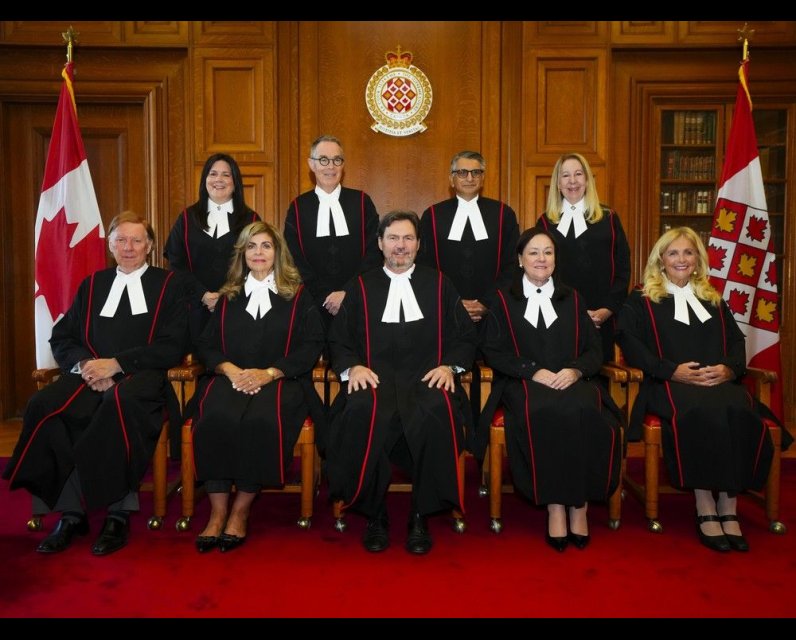Supreme Court's ditching of 'Santa robes' sparks sartorial debate among legal profession

The Supreme Court of Canada is marking its 150th anniversary this year and decided for the first time in 39 years to have a formal opening ceremony that involved an unveiling of sorts that has provoked debate among the legal profession.
The judges of the court donned new robes. New black fabric was highlighted with red piping on the fringes. Absent were the red robes with white mink fur trim, fondly known as “Santa robes.”
The simpler, made-in Quebec gowns are meant to represent a balance between weighty tradition and openness to future legal developments. They are also meant to reflect Canada’s identity and values more authentically, Chief Justice Richard Wagner told the Canadian Bar Association’s magazine, The National .
“They have a modern and simple design that echoes our commitment to openness and accessibility in a way that is distinctly Canadian,” he said to the legal publication.
It should be noted, however, that these were not the day-to-day working robes of the country’s highest court. When the court is in session, the judges wear traditional black robes , as barristers do in courts throughout the country. But Canadians not in the habit of watching SCC hearings on CPAC or via the court’s own website might think the Santa robes were de rigeur.
That said, the red robes trimmed with white were symbolic of Canada’s colours. Moreover, they were thought to be perfect for important occasions, such as the opening of Parliament or a visit from the King.
However, the heavy red gowns were known to be unpopular among some of the judges.
“Am I allowed to say, they’re awful,” Justice Andromaches Karakatsanis told CPAC eight years ago . “They’re so hot. They’re heavy … I’m glad that we wear (them) only for ceremonial events. I’m not sure I could do it every day.”
However, Justice Suzanne Côté shared a different view with CPAC. The court has traditions it needs to keep, she said, for instance, when “we wear our red robes for official events.” Decorum is important, she said, “given the type of institution that the court is.”
This judicial difference in opinion over the high court’s ceremonial fashion has been reflected in online debate among Canadian lawyers.
University of Calgary professor of law, Ian Holloway , has been highly critical of the change.
“Presumably, the chief justice is not criticizing the scarlet colour of the (ceremonial robes). After all, one can’t imagine that he would openly be throwing shade at the RCMP; the Mounties are about as iconically Canadian as you can get, and they’ve been wearing scarlet longer than the Supremes have. And for that matter, Canadian soldiers have been wearing ceremonial scarlet for even longer.”
Instead, Holloway suggests, “the principal objection to the current ceremonial robes is that they superficially resemble the robes worn by judges in England. Never mind that judges in places as diverse as Nigeria, Jamaica, New Zealand, and Australia also wear similar robes, the fact that ours have English roots makes them imperative candidates for the chopping block.”
A discussion on LinkedIn Tuesday reflected clashing sartorial opinions among the legal profession about the top court’s attire.
“No more Supreme Court of Canada judges as Santa Claus! Old robes are out. New Robes are in,” Jeremy Opolsky, litigation partner at Torys LLP wrote on LinkedIn Tuesday.
“I like these ones much better,” writes Myriam Seers, Toronto-based International disputes lawyer and arbitrator, responded. “They’re clean, modern and don’t (or shouldn’t) give rise to any point-and-laugh reactions by members of the public. That’s important when public confidence in institutions is constantly undermined on multiple fronts all at once.”
However, this was not a unilaterally shared view. Tax lawyer, Carl Irvine, didn’t pull his punches: “Boo! I liked the Santa Claus robes. Someone said these look like the leather package on somebody’s new Honda Civic.”
Comments from animal rights lawyer and Executive Director at Animal Justice, Camille Labchuk, may have gotten to the nub of one reason why the change was made.
“I love that they finally ditched the fur trim. A number of years ago I spoke with the owner of the robing company that created the Santa attire, and he told me each robe took the skin of 60 individual ermines who came from a fur farm,” wrote Labchuk. “Sends a great message that the Supreme Court is choosing modern, fur-free attire!”
Animal activists have been lobbying for the court to ditch the fur-lined robes for years.
Senior legal consultant, Thom Harley, brought these legal threads together in his LinkedIn post : “Some court watchers see balance and modernization. I see a loss of identity. After 150 years, that robe was more than costume. It was a visual signature, part of the institutional DNA of Canada’s highest court.
“If the old robes looked like ‘Santa suits,’ as some wags put it, the new ones now resemble something else: a sleek business suit with a stripe. Efficient, unremarkable, and easily forgotten in a crowd. The distinction between ceremony and everyday has blurred. … I don’t believe robes make the justice. But symbols matter. In law, institutions derive part of their authority from ritual, continuity, visual cues. When we strip those away, we risk making the Court look like just ‘another administrative body.’”
Our website is the place for the latest breaking news, exclusive scoops, longreads and provocative commentary. Please bookmark nationalpost.com and sign up for our daily newsletter, Posted, here.


Comments
Be the first to comment